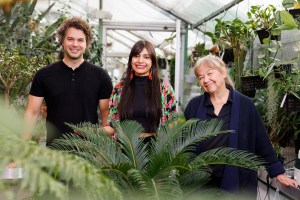Tag: Engineering
-
Science & Tech
Biohybrid of elastic film and muscle cells packs a punch
In an innovative marriage of living cells and a synthetic substrate, bioengineers at Harvard University have found that a rubberlike, elastic film coated with a single layer of cardiac muscle cells can semi-autonomously engage in lifelike gripping, pumping, walking, and swimming.
-
Campus & Community
John Lyell Sanders Jr.
John Lyell Sanders, Jr., served on the Harvard faculty for a total of thirty seven years and as Gordon McKay Professor of Structural Mechanics for over thirty years from 1964 until his retirement in 1995.
-
Campus & Community
Howard Wilson Emmons
Howard Wilson Emmons, Gordon McKay Professor of Mechanical Engineering, Emeritus, and Abbott and James Lawrence Professor of Engineering, Emeritus, the father of and a leading contributor to modern home fire research, died in his 86th year on November 20, 1998.At a Meeting of the Faculty of Arts and Sciences on May 16, 2006, the Minute…
-
Health
Spray-dry vaccine for TB developed
Bioengineers and public health researchers have developed a novel spray-drying method for preserving and delivering the most common tuberculosis (TB) vaccine. The low-cost and scalable technique offers several potential advantages over conventional freezing procedures, such as greater stability at room temperature and use in needle-free delivery. The spray-drying process could one day provide a better…
-
Campus & Community
DARPA funds new initiative at Harvard
The Defense Advanced Research Projects Agency (DARPA) recently announced its funding of a new multi-institution research initiative in nano- and micro-electro-mechanical systems (NEMS/MEMS) in affiliation with Harvard’s programs in engineering and applied sciences. The three-year program has more than $2 million in total funding from DARPA and industry partners.
-
Campus & Community
Sengupta wins $4.1 million ‘Era of Hope’ award for breast cancer advances
An assistant professor of medicine at Harvard has won a $4.1 million “Era of Hope” scholar award from the U.S. Defense Department’s Breast Cancer Research Program in support of his cutting-edge, interdisciplinary research aimed at fighting breast and other types of cancer.
-
Campus & Community
Harvard creates new, University-wide committee to guide interdisciplinary efforts in science
The Harvard Corporation has authorized the establishment of a new, University-wide standing committee on science and engineering to guide the University into a new era of collaborative, cross-disciplinary science initiatives. The Corporation also created a $50 million fund to provide initial support for the committee’s work, pending the submission of a budget by the committee.
-
Health
Schepens scientists first to discover angiogenesis switch inside blood vessel cells
Scientists at Schepens Eye Research Institute, an affiliate of Harvard Medical School, are the first to discover a switch inside blood vessel cells that controls angiogenesis (new blood vessel growth).…
-
Health
Researchers learn more about ways to regenerate the ear’s hearing cells
Massachusetts General Hospital researchers have made important progress in their ongoing effort to regenerate the inner ear’s hair cells, which convert sound vibrations to nerve impulses. In the Proceedings of…
-
Campus & Community
Engineering Idol
The winner of this year’s ES100-100hf senior engineering design project course competition aimed straight for the heart by recording an electrical “ballad.” The runners-up (a tie for second), meanwhile, worked…
-
Campus & Community
‘Armored’ bubbles can exist in stable nonspherical shapes
Researchers at Harvard University have demonstrated that gas bubbles can exist in stable non-spherical shapes without the application of external force. The micron- to millimeter-scale peapod-, doughnut-, and sausage-shaped bubbles,…
-
Science & Tech
Astronomers measure slowest motion across the sky
“A snail crawling on Mars would appear to be moving across the surface more than 100 times faster than the motion we measured for this galaxy,” said Mark Reid of…
-
Health
Researchers identify gene’s role in suppressing longevity
SIRT1 is involved in cellular senescence, or limitation of cells’ reproductive lifespan, a process thought to ensure that aging cells don’t pass on harmful mutations. Frederick W. Alt, a Howard…
-
Health
Protein reverses engineering of chromosome structure
An enzyme, a histone demethylase, removes methyl groups appended to histones, nuclear proteins that organize DNA and regulate gene activity. Methyl groups and other chemical tags on histones regulate how…
-
Science & Tech
Tiniest droplets produced from triangular nozzles
Ultra-tiny taps – which could, in theory, create drops just 8 billionths of a millimeter in size – might prove a boon for technologies that employ sprays of costly materials.…
-
Science & Tech
Puberty gene identified
A gene discovered by Harvard researchers and their colleagues in England makes a protein necessary to trigger a hormonal cascade that flows from the brain to the gonads. Without it,…
-
Science & Tech
Where do you want your building?
Humans are changing location more frequently and in greater numbers than ever before in history. But at the same time, the electronic revolution is allowing them to remain in contact…
-
Science & Tech
Atmospheric chemists fly high and low for novel carbon dioxide measurements
Political leaders throughout the world have taken notice of the increasing levels of carbon in the atmosphere and have begun negotiations on how to mitigate “greenhouse” gases through accords such…
-
Science & Tech
New use found for black silicon
In 1999, Harvard researchers used laser pulses to etch the surface of silicon, the most common substance used in electronic devices. By accident, they created a material that efficiently traps…
-
Science & Tech
Nebula resembles gigantic cosmic crossbow
NASA’s Chandra X-ray Observatory captured the details of a compact nebula that resembles a gigantic cosmic crossbow. The nebula, located in the Vela supernova remnant, is created as a rapidly…
-
Science & Tech
‘Ultracold’ trap unveils secrets of matter in the universe
Physics Professor John Doyle traps the tiny particles that make up the universe and then studies them, looking for what they can tell him about the most basic rules of…


